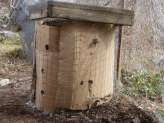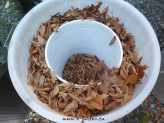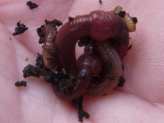Compost Pile
What goes in it? and how do you do it?
Making a compost pile is one trick I recommend all gardeners get down pat.
It’s not difficult, but there are a few little tips I can share with you.
First of all, make sure that all your ingredients are chopped up a bit.
How many times have I dug into a compost pile that seemed to be almost ready to use, only to find a kohl rabi, still perfectly preserved, looking exactly the same as when it went in?
Chopping those really woody ingredients like corn cobs, citrus rinds, squash, the roots of the cabbage family into smaller pieces lets those little microorganisms get their teeth around them easier – they don’t really have teeth, actually, so that makes it even more difficult for them.
Some really avid composters put their kitchen scraps into a blender, just to make it really easy for the micro herd. I draw the line.
Breaking up the larger chunks will help the whole pile break down much faster.
I keep a big knife handy, to chop the pieces up, or I use a shovel while I’m turning the compost over to aerate it, or my handy little trenching spade which has a serrated edge to chop away at the larger pieces.
Another
way to break down the pieces before you add them is to let them freeze,
then if your pile is really hot with activity, they are pre-digested
and can be worked on immediately by the micro organisms and worms.
Make your compost pile fairly close at hand especially through the winter, if you get lots of snow and ice. A slog through snow that is over your knees to dump the overflowing compost bucket just takes all the fun out of it.
I use a double wire cylinder method to keep the inner compost pile insulated through the winter – fill the outer ring with fall leaves.
In the late winter, when the compost pile normally would be frozen solid, the worms will be happily munching on the kitchen scraps you’ve been putting in there.
When the pile slows down, and it's hard to tell the origins of the ingredients, it's time to use it. Sifting your compost with an expanded metal sieve to get the larger bits gives you some extra special seed starting mix.
Wanna make your very own compost tumbler?
Make sure that you pasteurize the finished compost before
using, to kill the weed seeds. Use a black peat moss or soil mix bag, and leave it for a few weeks in a sunny place to solarize it.
A wire hardware cloth sieve is second choice, to be used only if you can’t get a piece of expanded metal.
Your compost pile will be a thing of pride, and rightfully so.
How else can you take garbage, and
make it into such great natural fertilizer?
How do you Compost?
What's your favorite way to compost? Do you have a custom built bin? Salvaged pallets, wired together? A piece of fence, in a cylinder? Share your idea here...
See more great Composting Ideas here...
Other visitors have shared their methods here:
Spilled Grain and Animal Feed
I found out pretty much by accident about using spoiled grain and chick scratch, alfalfa pellets and other animal feed by layering it into my compost pile, …
A Plain Old Compost Pile
If you have room, and an out of the way place to use, a simple pile of materials will rot down slowly and quietly, giving you well ripened slow compost. …
My Wire Compost Bin
After many years of making compost, I started using this method for building bins to hold fall leaves and then got the idea of making my winter compost …
Hannekes Place Compost Bin
This is one of the nicer compost bins I've seen; neat and tidy, well built and sturdy, and obviously well thought out. Not every compost bin made from …






New! Comments
Have your say about what you just read! Leave me a comment in the box below.